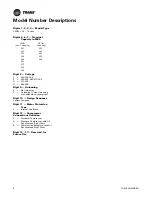
COM-SVN003B-EN
11
Removal and Installation
Only qualified personnel should install or repair
refrigeration systems. If you are not qualified, seek the
services of qualified personnel. The steps listed below are
not meant to be an exact step-by-step procedure, but are
intended to identify procedures or precautions that may
be unique to a Trane compressor and should be taken into
account to properly and safely remove and install the
compressor. Each installation has its unique set of
circumstances which must be considered by the service
technician to perform a safe and successful compressor
replacement.
Removal
•
Prior to removing the compressor, open the unit
disconnect and place a lock on the disconnect to
prevent someone else from accidentally applying
power to the unit while it is under repair.
•
Completely recover the refrigerant from the refrigerant
circuit being repaired. Do not release refrigerant to the
atmosphere! Use Responsible Refrigerant Practices. If
adding or removing refrigerant, the service technician
must comply with all Federal, State, and local laws.
•
Before removing the electrical connections on the
compressor, use a voltmeter to check for the absence
of power on the compressor power terminals.
•
After confirming the absence of power, remove the
electrical connections.
•
Remove and measure oil from failed compressor prior
to compressor removal:
–
CSHW compressors have an oil drain valve (see
) that allows oil to be drained out of the
compressor. After the refrigerant has been
recovered, pressurize the system with nitrogen to
help remove oil from the compressor.
–
Record the amount of oil removed from the failed
compressor. The replacement compressor oil
charge should be adjusted to ensure that the
equivalent amount of oil remains in the unit.
Tip:
Before removing the existing tubing from the
compressor, apply flux to the joint. This will aid in
the flow of the braze material and help keep the
joint clean for rebrazing. After fluxing, heat the joint
evenly to slightly higher temperature than the
melting temperature of the filler material. At this
point, the two parts of the assembly should be
easily separated.
•
Refrigerant Connection Removal
Single compressor—Cut the refrigerant lines in a
convenient location that allows reassembly with slip
couplings. Then, unbraze the line from the compressor
and reuse it when the replacement is installed.
WARNING
Refrigerant under High Pressure!
Failure to follow instructions below could result in an
explosion which could result in death or serious injury
or equipment damage. System contains oil and
refrigerant under high pressure. Recover refrigerant to
relieve pressure before opening the system. See unit
nameplate for refrigerant type. Do not use non-
approved refrigerants, refrigerant substitutes, or
refrigerant additives.
WARNING
Hazard of Explosion and Deadly Gases!
Failure to follow all proper refrigerant handling
practices could result in death or serious injury.
Never solder, braze or weld on refrigerant lines or any
unit components that are above atmospheric pressure
or where refrigerant may be present. Always remove
refrigerant by following the guidelines established by
the EPA Federal Clean Air Act or other state or local
codes as appropriate. After refrigerant removal, use dry
nitrogen to bring system back to atmospheric pressure
before opening system for repairs. Mixtures of
refrigerants and air under pressure may become
combustible in the presence of an ignition source
leading to an explosion. Excessive heat from soldering,
brazing or welding with refrigerant vapors present can
form highly toxic gases and extremely corrosive acids.
WARNING
Pressurized Burning Fluid!
Failure to follow these instructions could result in death
or serious injury. Before opening a system, you must
remove refrigerant from both the high and low sides of
the system. If the pressure is not removed from both
sides of the system, pressure could still exist in the
system. If a torch is used to unbraze the tubing the
refrigerant and oil mixture could ignite.
WARNING
Hazardous Voltage w/Capacitors!
Failure to disconnect power and discharge capacitors
before servicing could result in death or serious injury.
Disconnect all electric power, including remote
disconnects and discharge all motor start/run
capacitors before servicing. Follow proper lockout/
tagout procedures to ensure the power cannot be
inadvertently energized. Verify with an appropriate
voltmeter that all capacitors have discharged.
For additional information regarding the safe discharge
of capacitors, see PROD-SVB06*-EN.










































